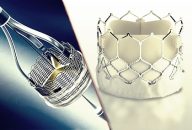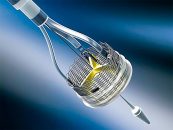Courtesy of Dr. Agustín Vecchia. As TAVR is expanded to lower risk patients, complications become more relevant. As regards stroke, the PARTNER 2 and SURTAVI one year outcomes are 8.0% and 8.2% respectively. The mechanisms behind this complication have not yet been clarified and, therefore, neither have guideline recommendations in this regard (as we can tell…
Lotus vs Sapien 3, different mechanisms with similar results
The new generation devices for transfemoral transcatheter aortic valve replacement have been optimized to improve valve position and reduce residual aortic regurgitation. This study compared 30 day, 12 month and 24 month outcomes of the repositionable, Lotus valve, with controlled mechanical expansion, and the balloon-expandable valve Edwards Sapien 3. Primary end point was all cause mortality…
How can we classify aortic stenosis in patients who underwent TAVR?
Courtesy of Dr. Carlos Fava. Aortic stenosis can present different hemodynamic patterns, such as low flow and low gradient with reduced or preserved ventricular function. However, evidence on the evolution of different hemodynamic patterns after transcatheter aortic valve replacement (TAVR) is limited. This study consisted in a retrospective analysis of 368 patients who underwent TAVR. The population was divided in…
Increasing operator experience improves TAVR outcomes
The introduction of transcatheter aortic valve replacement (TAVR) into clinical practice in the United States has been a tightly controlled process aimed at optimizing patient outcomes and minimizing the learning curve. Many strategies have been used to reach a rational dispersion for this new technology, including choosing sites with enough volume, and adequate operator training…
Lotus Valve performance related to pacemaker implantation in patients after TAVR
Courtesy of Dr. Agustín Vecchia. Paravalvular leak was once considered the greatest disadvantage of TAVR when compared to conventional surgery. Nowadays, new devices and more-experienced operators have managed to “control” this phenomenon, keeping related statistics within acceptable ranges. Repositionable-valve Lotus may probably offer the most effective solution for this event; however, it is associated with high rates of…
MitraClip: Should We Intervene Earlier?
Courtesy of Dr. Carlos Fava. Repairing the mitral valve with Mitraclip has become an alternative for high risk or inoperable symptomatic patients, but its long term evolution has only been tested by the EVEREST II, which had not taken into account 5 year mortality outcomes. Therefore, to better study its evolution, we need to carry out different randomized studies…
Post-dilation in TAVI associated to more stroke and more paravalvular regurgitation
Courtesy of Dr. Carlos Fava. Moderate/severe paravalvular regurgitation (PVR) after TAVR is present in 10%-14% of all cases, according to different series. The treatment of choice is post-dilation, generally effective in most cases. However, this strategy carries a risk of stroke. The true impact of this conduct is still unclear. This review analyzed 6 studies that included 5007 patients; 889 of…
Transcatheter valve replacement in the bicuspid valve is increasingly performed, but challenges remain
As experience increases, transcatheter aortic valve replacement (TAVR) has expanded to different populations and anatomies. This study sought to compare technical and clinical outcomes in patients with bicuspid versus tricuspid aortic stenosis from the Bicuspid AS TAVR Multicenter Registry. Outcomes of 561 patients with bicuspid valves and 4546 patients with tricuspid valves were compared. Propensity score matching was used…
Incidence, characteristics, and treatment of valve thrombosis after TAVR
Certain studies have carried out a tomographic follow-up of patients who underwent transcatheter aortic valve replacement (TAVR) and described the frequency of leaflet thrombosis; however, in most cases, it is unclear whether this finding requires some sort of intervention. The difference between this work and those previously published is that this study is not focused on imaging, it…
SENTINEL study: cerebral protection during TAVR
Neurological complications during and after transcatheter aortic valve replacement (TAVR) are probably the only event whose incidence has not been reduced by new valve designs (as opposed to paravalvular leak, vascular complications, or need for pacemaker implantation). Aside from the potential seriousness of this clinical event, the risk of embolism is particularly worrisome because,…
In-hospital morbid-mortality rates for balloon aortic valvuloplasty are similar to those for transcatheter aortic valve implantation
Courtesy of Dr. Carlos Fava. The balloon aortic valvuloplasty (BAV) was introduced by Dr. Cribier in 1986. However, given its poor results, soon after it fell into disuse. With the introduction of TAVR, it saw a revival as bridge for another intervention, even though it is still resisted in many places. The present study…










